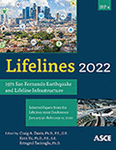Agents of Change for Resilient Infrastructure
Publication: Lifelines 2022
ABSTRACT
The effects of hurricanes with respect to infrastructure resilience are reviewed with reference to Hurricanes Katrina and Sandy. The effects of Hurricane Sandy on New York City and subsequent programs to improve the City’s infrastructure are described. Special attention is focused on the restoration of the L Line Tunnel, which was flooded by Hurricane Sandy. The paper describes how a team from Cornell and Columbia Universities was assembled at the request of Governor Andrew Cuomo to help re-engineer a $0.5 billion project to rehabilitate the tunnel, and still keep the subway in service. The new approach integrates several advanced technologies, including distributed fiber optics and light detection and ranging (LiDAR). The agents of change that lead to improved policies and approaches are explored, including the technical, institutional, and social challenges of introducing new technologies and engaging community support.
Get full access to this article
View all available purchase options and get full access to this chapter.
REFERENCES
City of New York. “A Stronger, More Resilient New York” (2013). Mayor Michael R. Bloomberg, <https://www1.nyc.gov/site/sirr/report/report.page>(Nov. 18, 2020).
Dai, A., Wigley, T. M. L., Boville, B. A., Kiehl, J. T., and Buja, L. E. (2001). “Climates of the Twentieth and Twenty-First Centuries Simulated by the NCAR Climate System Model” J. Climate, 14(4), 485-519.
Istanbul Metropolitan Municipality. (2008). “Population and Demographic Structure”, Istanbul 2010: European Capital of Culture.
Kurt, S. (2014). “The Course of Population Growth in Southwestern Coasts of the Sea of Marmara and Its Spatial Distribution”, Chapter in Urban and Urbanization, D. Recep, T. Tuzun, I. Sharuho, and E. Atasoy, eds., Kliment Ohridski University Press.
NFPA (National Fire Protection Association). (2020). “Standard for Fixed Guideway Transit and Passenger Rail Systems”,.
NYCEDC (Ney York City Economic Development Corporation). (2019). “Lower Manhattan Climate Resilience Study”, <https://edc.nyc/sites/default/files/filemanager/Projects/LMCR/Final_Image/Lower_Manhattan_Climate_Resilience_March_2019.pdf>(Nov. 18, 2020).
O’Rourke, T. D. (2019). “The Rapidly Growing Need for Resilient Infrastructure”, Editor’s Note, The Bridge, National Academy of Engineering, Summer.
O’Rourke, T. D. (2017). “Critical Infrastructure, Interdependencies, and Resilience” The Bridge, National Academy of Engineering, Spring.
O’Rourke, T. D., Lembo, A. J., and Nozick, L. K. (2003). “Lessons Learned from the World Trade Center Disaster About Critical Utility Systems”, Beyond September 11th: an Account of Post Disaster Research, Natural Hazards Research and Applications Information Center, Boulder, CO, 269-292.
Roser, M., Ritchie, H., and Ortiz-Ospina, E. (2013). “World Population Growth”, <https://ourworldindata.org/world-population-growth>(Nov. 18 2020).
Soga, K., and Schooling, J. (2016). “Infrastructure Sensing”, Interface Focus 6: 20160023, <https://royalsocietypublishing.org/doi/pdf/10.1098/rsfs.2016.0023>(Nov. 18, 2020).
White House. (2011). Presidential Policy Directive/PPD-8: National Preparedness, Washington, D. C.
Information & Authors
Information
Published In
History
Published online: Nov 16, 2022
Authors
Metrics & Citations
Metrics
Citations
Download citation
If you have the appropriate software installed, you can download article citation data to the citation manager of your choice. Simply select your manager software from the list below and click Download.
